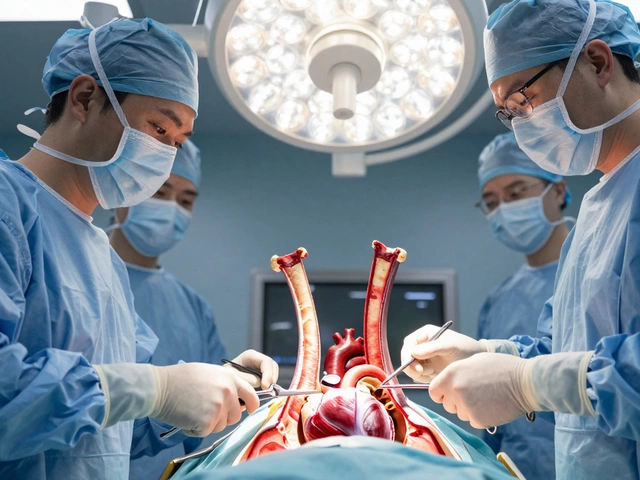- Home
- Health And Wellness
- The Hardest Heart Surgery: Deep Dive into Complex Cardiac Operations

The Hardest Heart Surgery: Deep Dive into Complex Cardiac Operations
Every year, thousands of people place their lives in the hands of surgeons for heart surgery. But not all heart surgeries are equal. Some push even the best doctors to their limits. There are operations that demand steel nerves, split-second decisions, and a deep well of experience—where even a tiny mistake can make the difference between life and death. If you think open-heart surgery is tough, wait until you hear about heart transplant operations and something called the ‘Norwood Procedure.’ These are the kinds of surgeries that make other surgeons sweat. Why are they so insanely difficult? Let’s get to the heart of it—literally.
What Makes a Heart Surgery the Hardest?
When you hear "heart surgery," you probably think of bypasses or valve repairs. While those are tricky, there’s a different league reserved for extreme cases. The toughest ones usually tick at least three boxes: operating on fragile patients (think infants or those with failing organs), working against the clock, and handling surgery on a heart that may have stopped beating or never worked right in the first place.
The material surgeons handle doesn’t exactly behave like soft clay. The heart is slippery, constantly moving, and surrounded by tiny blood vessels. Some surgeries require stopping the heart altogether and running the patient through a heart-lung machine—yes, an actual machine that takes over the job of pumping and oxygenating blood. Others, like the infamous Norwood Procedure, involve totally rerouting new-borns’ blood flows with just millimeters of error allowed. You know it’s tough when the textbooks say, “Survival is possible, but expect complications.”
Top on the list? Heart transplants, the Norwood Procedure for babies with single ventricle defects, and complex repair of aortic dissections. Take heart transplant as an example—imagine removing someone’s diseased heart and sewing in a fresh one within tight time windows. If the timing’s off by even minutes, tissue can die. In a study published in the Journal of Thoracic and Cardiovascular Surgery, the average heart transplant takes around 4-6 hours but can easily become longer when complications pop up. You’re juggling immunosuppressants, unpredictable bleeding, and a body that might reject its new engine, sometimes right on the operating table.
Then there’s the Norwood Procedure. Performed on babies born with hypoplastic left heart syndrome (meaning only half their heart works), this operation needs crazy precision. The first stage often happens within days of birth. Surgeons must reconstruct the baby’s aorta and reroute circulation so they can survive. Complications? Let’s just say parents are prepping for round-the-clock care after. Only about 70% of infants survive the first operation, and they usually need two more major surgeries before age three. Can you imagine stitching up blood vessels thinner than spaghetti noodles, knowing one slip could be catastrophic?
What makes these surgeries so tough isn’t just the hands-on difficulty. There’s also massive pressure. Surgeons have to make micro-adjustments while dozens of people—nurses, anesthesiologists, support staff—watch and work together seamlessly. The OR can go from calm to chaos in seconds, especially if something starts to bleed unexpectedly.
The Heart Transplant: When the Clock is Ticking
When someone needs a new heart, things are already dire. The process is brutal, from matching a donor (which is usually a matter of hours) to keeping the donated heart viable on ice. Organs begin to die after four hours out of the body. So, surgeons often work fast, sometimes through the night, knowing every minute counts. Patients waiting for a donor heart average a wait time of 6 months to a year, but some die before their turn comes.
Let’s break down what happens. Operating teams retrieve the donor heart—sometimes from a hospital miles away—preserved in a special solution and packed on ice. Surgeons race against ischemic time (the moment an organ is without blood supply). The minute the donor heart arrives, the countdown begins. The patient is placed on a heart-lung machine; the old heart comes out, and the new one gets stitched into place. Four main connections—two vena cava veins, the aorta, and the pulmonary artery—must fit perfectly, and then blood flow is restored. The moment of truth comes when the new heart, hopefully, kicks in and starts beating.
Heart transplants bring a unique challenge: rejection. The immune system is programmed to attack anything “foreign.” Surgeons and their teams have to manage this with powerful immunosuppressant drugs and constant monitoring. Some patients face “hyperacute rejection,” where the new heart falls apart within minutes. Others battle chronic rejection for years.
Numbers from the United Network for Organ Sharing (UNOS) show about 3,500 heart transplants happen annually in the U.S. Survival depends on things like age, underlying diseases, and how quickly the new heart is connected. The one-year survival rate is about 90%, and five years is roughly 75%. It seems decent—until you realize how grueling the path is, for both patient and surgeon.
| Type of Heart Surgery | Average Survival (1 Year) | Major Risk Factor |
|---|---|---|
| Heart Transplant | ~90% | Rejection, Infection |
| Norwood Procedure (Stage 1) | ~70% | Multiple surgeries, Organ failure |
| Coronary Bypass | ~98% | Bleeding, Heart attack |
| Aortic Dissection Repair | ~85% | Stroke, Kidney failure |
Surgeons go through years of specialized training just to earn the right to perform these; even then, only a handful ever reach the level where they’re trusted to take the lead. Top cardiac surgeons often share an almost superhuman level of focus and emotional control. There’s a reason some joke it’s the “Olympic sport” of the medical world.

The Norwood and Other High-Stakes Pediatric Surgeries
Pediatric heart surgery—talk about pressure. Imagine being asked to fix something the size of a grape in the tiniest patients, whose bodies haven’t even fully developed. Steps have to happen in exact order: rerouting blood flow, building new pathways with tissue grafts, placing shunts, and then hoping everything holds together as the infant grows. Breakdowns or leaks after surgery can mean more emergency operations.
The Norwood Procedure stands out. Here’s the rough idea: babies born with only one working pumping chamber need complete heart rewiring to survive. The first operation rebuilds their aorta and hooks their body’s circulation directly to their lungs. Later surgeries (the Glenn and Fontan procedures) further fine-tune blood flow, each carrying their own set of risks. In between? Weeks of hospitalization, feeding tubes, and constant monitoring for heart failure or rhythm issues.
The stakes are sky-high. Unlike adult surgeries where patients can describe pain, infants show only subtle signs. Surgeons rely on numbers—oxygen levels, blood pressure, ECG lines. Mistakes can snowball. Data from the Society of Thoracic Surgeons show that centers performing pediatric heart surgeries have highly variable results, with survival rates linked to experience. Only top-ranked programs, usually at large children’s hospitals, consistently achieve good outcomes.
Coping as a parent is a feat in itself. Families camp out in the waiting room, living hour to hour as social workers, cardiologists, and nurses rotate in and out. Tips for parents? Build a support network, ask questions (even the scary ones), and remember that online resources like the Children’s Heart Foundation can be more comforting than a generic web search.
Reality in the Operating Room: Human Hands, High-Tech Tools, and Unpredictability
Even with all the fancy monitors and machines, at the center of these hardest heart surgery cases is a team of humans doing incredibly difficult work. Tools have advanced hugely since the first heart surgeries in the 1900s. Surgical robots, 3D-printed heart models, and detailed imaging scans help surgeons plan and rehearse what they'll do. Still, every operation is different. Scar tissue, oddly shaped hearts, or complications from past surgeries can throw curveballs the team didn’t expect.
The best surgeons aren’t just skilled—they’re quick on their feet. Stories from the OR sound almost unreal: a patient’s blood pressure drops suddenly, and the team jumps into action, clamping vessels and racing to find the leak. Or during transplant, the new heart doesn’t start right away, and the surgeon calmly massages it by hand, waiting for that first hopeful beat. What keeps these teams sharp? Constant practice, hours in anatomy labs, and a ‘checkpoint’ culture where anyone can point out a potential risk, no matter their job title.
There’s a flip side to all the intensity: breakthroughs come from these high-stakes moments. For example, transplant survival rates keep getting better as the drugs to fight rejection improve. Some hospitals now use portable machines to keep donor hearts beating even while they’re in transit—a game-changer for longer journeys. Others are testing stem cell injections to help repair weak spots during surgery. Surgeons share case studies at big conferences and through global professional groups to spread these advances, so the knowledge gap shrinks for the next desperate patient.
Tips for anyone facing or supporting someone through heart surgery? Be part of the conversation—surgeons and teams want your questions. Ask for details on recovery time and possible setbacks, since even ‘routine’ heart surgeries can mean weeks of fatigue or new meds to manage. Know your hospital's outcomes, too. Large centers often have better stats, especially for rare or complex procedures. Bring a trusted friend to appointments and keep a notebook. Details can be overwhelming in the middle of a health crisis. And if you ever doubted the skill and gut-level courage it takes to be a heart surgeon, watch just one heart procedure video (if you have the stomach for it)—you’ll never take your ticker for granted again.

Arnav Singh
I am a health expert with a focus on medicine-related topics in India. My work involves researching and writing articles that aim to inform and educate readers about health and wellness practices. I enjoy exploring the intersections of traditional and modern medicine and how they impact healthcare in the Indian context. Writing for various health magazines and platforms allows me to share my insights with a wider audience.
Popular Articles
About
Medical Resource Center India is a comprehensive online platform dedicated to providing reliable health information and medical resources in India. Explore a wide range of articles, tips, and advice on medicine, healthcare services, and wellness. Stay informed about the latest developments in Indian medicine and access valuable insights into maintaining a healthy lifestyle. Discover expert guidance and health solutions tailored for every Indian citizen. Your go-to destination for authoritative medical knowledge in India.






